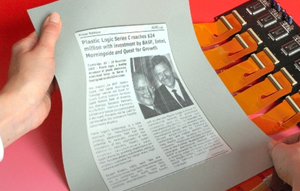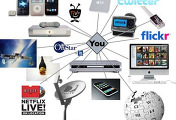전자종이가 눈부시게 진화하고 있다. 칼라를 완벽하게 구현하고 구부러지는 기기로 탈바꿈할 준비가 착착 이뤄지고 있는 것이다. 일본 아사히신문은 최근 글로브판에서 전자종이를 종이신문의 '구세주'로 타진하는 와이어드(Wired) 기자 스티븐 레비(Steven Levy)의 기사를 실었다. 미국, 유럽 등에서는 전자종이에 합류한 신문들이 늘고 있으나 아직 성공을 판단하기는 이르다. 국내에서는 조선일보가 지난해 힘겨운 실험을 진행했다.
스티븐 레비의 전자종이 낙관론은 앞으로 몇 년내 국내에서도 검증받게 될 것이다. 그런 점에서 그의 기사 전문(영어)와 번역본을 게재한다.
전자종이는 종이신문의 구세주인가? - 아마존 킨들을 통해 본 신문과 잡지의 미래
1965년 10월17일자 뉴욕타임스 일요판은 모두 946페이지, 3kg에 달하는 것이었다. 이는 유례없는 두꺼운 신문이었다. 그런 신문을 전자종이로 만드는 시도가 진행되고 있다. 사진, AP통신
인쇄매체가 신음하고 있다. 인터넷에 의해 부숴지는 비즈니스 모델에 이어 경기침체는 이어지고 있다. 젊은 세대는 신문을 멀리하고 있다. 이제 기자들도 절감하고 있다. 정보 유통은 웹으로 넘어가고 있지만 거기에선 큰 수익을 얻을 수 없다. 거의 매일 미디어 기업의 새로운 레이오프(layoff), 폐쇄, 파산 소식이 들린다. 짖궂게도 이러한 뉴스는 인쇄 매체를 파묻으려는 신기술-블로그, RSS 피드 등에 의해 전달되고 있다. 심지어 "(전통)미디어는 죽고 있다"는 이름의 트위터(Twitter) 블로그도 있다.
그러나, 나는 그 전에 희망을 찾아내고자 한다.
서적을 재현하는 킨들
미국 아마존(Amazon)에서 판매되는 킨들(Kindle)
킨들은 신문과 잡지까지 다운로드할 수 있다. 나는 그중 몇개를 구독하면서 미래를 위한 힌트를 얻었다. 예를 들어 뉴욕타임스나 아틀란틱 매거진 같은 종이를 구독하는 경우 일순간에 그날의 신문이나 잡지를 확보할 수 있게 된다. 낡음과 새로움을 융합한 것은 가슴을 뛰게 한다.
불운하게도 이러한 것은 아직 완전히 출판물과 일치하지 못하고 있다. 흑백 스크린은 갑갑하고 그래픽은 완벽히 구현되고 있지 못하다. 콘텐츠를 볼 수 있는 경로들도 원활하지 않다.
만약 현재의 킨들이 아니라 신문과 잡지에 최적화한 꿈의 리더기(Dream Reader)가 나온다면 상황은 달라지지 않을까. 잡지의 양쪽 페이지를 펼쳤을 때의 사이즈처럼, 그리고 접어서 가지고 다닐 수 있는 것 말이다. 여기에 고해상도의 칼러 스크린과 세련된 터치 스크린의 인터페이스도 갖고 있다면! 더구나 싸기까지 하고 인터넷에 접속해 새로운 기사를 볼 수 있다면 금상첨화일 것이다.
인터넷 서핑용은 아니다
그러나 그것은 인터넷 서핑을 위한 단말기는 아니다. 브라우저는 신문이나 매거진을 위한 것이 아니다. 인쇄판에서는 편집자들은 독립적인 개별 기사를 하나의 패키지에 구성해 하나의 완성 상품을 만들어 낸다. 기사를 서열화(Ordering)하는 것으로 연속성과 내부의 이야기의 흐름을 담는다. 반면 웹 사이트에서는 (편집의) 제한이 없다. 독자들은 마음대로 한 기사에서 다음 기사로 이동한다. 때로는 사이트를 아주 떠나 돌아오지 않기도 한다. 따라서 하나의 패키지라고 보기는 어렵다.
책을 읽는 느낌을 주는 킨들처럼 ‘드림 리더’는 신문이나 잡지를 개별의 출판물로 제공한다. 공급자가 정리한 대로 몰두하게 된다. 이러한 디지털 출판물은 미리 구독을 할 수 있는 시간대로 이끌게 된다. 구독자들은 아주 기쁘게 기다릴 것이다. 또한 인쇄매체처럼 인쇄, 물류비융, 종이가격 등이 들지 않아 저렴하다. 이른 아침 조간신문은 일면부터 만화까지 번개처럼 나타날 것이다. 일주일에 한 차례는 주간 뉴스판도 받게 될 것이다. 또 한 달에 한번씩은 패션, 라이프스타일, 스포츠매거진도 받을 수 있을 것이다. 디지털 기술에 힘입어 오디오, 동영상, 애니메이션 등을 제공받게 될 것이다.
칼라와 접이식도 구현
플라스틱 로직社의 전자종이 시제품. E-ink社의 전자잉크를 이용하고 있다.
그렇다면 드림 리더의 비즈니스 모델은 무엇인가? 적어도 인터넷이 나타나기 전까지 인쇄매체가 수십년간 지탱해온 방법을 사용할 수 있다. 광고다. 기사 옆이나 좌우 양면 페이지에 배치되는 식이다. 물론 개선이 될 것이다. 광고는 개인 단말기의 속성에 따라 역동적으로 게재될 것이다. 광고를 터치하면 부가적인 정보를 보거나 보너스 콘텐츠도 이용하는 식으로 말이다.
디자이너나 엔지니어는 이러한 기술을 완성시키려고 노력 중이다. 킨들에 공급되는 E-ink社의 경우 칼라버전을 준비 중이다. 플라스틱 로직(Plastic Logic)社는 초미세 기술을 사용하여 신문 사이즈의 고해상도 디스플레이를 연구 개발중이다. 폴리머 비전(Polymer Vision)社는 유연성이 있는 접이식 디스플레이를 만들고 있다. 초기 화면의 인터페이스를 쉽게 하기 위한 노력도 이뤄지고 있다. 가장 잘 알려진 뉴욕타임스의 타임스리더(Times Reader)가 그렇다. 여기에 아이폰(iPhone)의 터치 스크린이 결합하면 드림 리더의 완벽한 요소들이라고 할 것이다.
드림리더가 나타날 때 출판업자들은 자사 콘텐츠에 합리적 요금을 붙여 판매할 기회를 가지게 될 것이다. 또 고가의 광고도 삽입할 수 있을 것이다. 유감스러운 대목은 이 기기가 본격적으로 대중화하기까지 많은 언론사들이 문을 닫게 될 것이라는 점이다. 드림리더가 나타났지만 수많은 언론사들이 그 혜택을 누리지 못한채 없어진 상태라면 그것은 너무도 안타까운 일이라고 할 것이다.
* 스티븐 레비(58), 뉴스위크 편집장, 테크놀러지 기자를 거쳐, 와이어드 잡지 시니어 라이터를 맡고 있다. <iPod는 무엇을 바꾸었는가>, <암호화> 등의 저서가 있다.
Dream Reader -- a possible savior of the media
These are the panic days for print media. With business models battered by the Internet, the overall economy sagging, and a generation of youngsters who have never had their fingers stained from newsprint ink, journalists feel besieged. Publications are moving to the Web, but not making much money from it. Every day brings dispatches of new layoffs, closings, and bankruptcies. Adding insult to injury, these are most efficiently reported by the new technologies that are killing us-on blogs, RSS feeds, and a stream of "Twitter" bursts from a source called The Media Is Dying.
But I see hope ahead.
The realization first came to me while testing Amazon's Kindle. This is dedicated reading device that tries to emulate the experience of reading a book, with augmentations and features possible only because of its digital nature. (Like the ability to store tens of thousands of pages in a small package, a way to instantly refresh with new publications, and the power to search through the contents.) The Kindle uses a technology called e-Ink, which resembles a black-and-white printed page and gets new content electronically via the Amazon store. But it is successful in its main purpose-delivering the intensity of reading a real book-because while you're reading, it shuts out the rest of the world. You focus solely on text.
The Kindle also downloads newspapers and magazines, and when I began to sign up for some of these, I realized that I was getting a hint of a rosier future ahead. When you subscribe to a paper like the New York Times or a magazine the
What if, instead of the current Kindle, one had a reading device that was optimized for newspaper and magazines-a Dream Reader. Something that would open to the size of a two-page spread in a magazine, yet, like the real thing, could be folded up so you could always take it with you. The screen would be high-resolution color, and have a sophisticated touch interface. Yet it would be inexpensive--cheap enough to lose. And it would, of course, be capable of connecting to the Internet to get new material.
But it would not be an Internet surfing device. Browsers are not friendly to the virtues that make newspapers and magazines great. In print versions, editors must painstakingly assemble a discrete package of stories to make a complete product. Ordering the stories brings a sense of continuity and an internal narrative. If late in the process, a late-breaking story comes in, something must be taken out to accommodate it. On Websites, however, there's no limit to how much can be posted, so there's no need to brutally winnow. And readers jump randomly from one story to the next-and often leave the site entirely, never to return. The idea of a complete package is lost.
Like the Kindle does with books, the Dream Reader would present publications discretely, immersing readers in a single world, bound by the vision of those who produced it. And because these digital publications arrive at prescribed times, in a quick digital squirt, they will be eagerly awaited by (paying) subscribers. (Prices will be low because there are no costs in paper, printing, or physical distribution.) In the wee hours of the morning, your daily newspaper appears, and you will thumb through it from the front page to the animated comics. Once a week you will receive, all at once, the pages of newsweeklies. You will also anticipate the time of month when your favorite fashion, lifestyle, and sports magazines rush into your Dream Reader. They will be every bit as visually sumptuous as the most sumptuous glossy, but could also draw on every trick that digital technology has to offer-animation, sound, pop-up sidebars…anything imaginable.
What is the business model for Dream Readers? The same one that has sustained print for decades, at least until the Internet came along. Ads will simply run alongside articles, or on facing pages. Of course, there can be refinements-ads can dynamically be placed according to the demographics of the individual reader. And touching an ad can yield more information on a product, or even bonus content.
Designers and engineers are rushing to perfect the underlying technology that will make these readers possible. E-ink, the tech supplier for the Kindle is readying a color version. A company called Plastic Logic is using nanotechnology to produce a newspaper-sized high-resolution display. Another company, Polymer Vision, is making a "roll-away" display that adds flexibility to the equation. On the interface front there are a number of experiments that let you navigate a single publication; the most renowned is the (
When the Dream Reader does arrive, publishers will have an opportunity to charge reasonable prices for their content, which will sit beside high-cost advertisement. The only danger is that while we wait for these devices to flower and mature, we may lose more and more of our journalistic institutions. How sad if Dream Readers arrived and many of our greatest publications weren't around to take advantage.
'뉴미디어' 카테고리의 다른 글
| 인터넷 지도, 새로운 시장의 얼굴되나 (4) | 2009.02.19 |
|---|---|
| 스마트폰 시장은 열리나 (4) | 2009.01.22 |
| 올해 뉴미디어 시장, '잿빛전망' 속 경쟁치열할듯 (0) | 2009.01.02 |




댓글